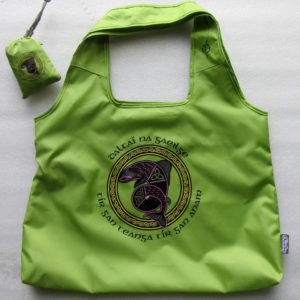Fáilte (Welcome) › Forums › General Discussion (Irish and English) › Suimiúil…
- This topic has 3 replies, 1 voice, and was last updated 11 years, 1 month ago by
duḃṫaċ.
-
AuthorPosts
-
March 13, 2013 at 9:27 pm #36500
Séril Báicéir
ParticipantI came across the picture attached at the bottom along with this paragraph by the person who posted it:
The Irish werewolf is different from the Teutonic or European werewolf, as it is really not a “monster” at all. Unlike its continental cousins, this shapeshifter is the guardian and protector of children, wounded men and lost persons. According to some ancient sources, the Irish werewolves were even recruited by kings in time of war. Known in their native land as the faoladh or conroicht, their predatory behaviour is typical of the common wolf, not beneath the occasional nocturnal raid .
But the picture itself has a paragraph as Gaeilge that I was trying to read, but I cannot figure out what the word “faelad” means…form? creature? one of the fae? Here is the paragraph from the picture:
Is féidir le roinnt fir a ghlacadh ar faelad, ar shlí eile ar a dtugtar mac tire-cruthanna. Bhí ar a dtugtar siad as a gcuid neart i cath, agus cumais mór.
Any help on this would be great! Go raibh maith agaibh!
SérilMarch 13, 2013 at 10:02 pm #43521Séril Báicéir
ParticipantThat may be why I was having so much of a problem reading it, a Charmanach. So “faelad” means werewolf? It’s funny that I wouldn’t have pictured the word for werewolf being “faelad.” I wonder if that’s historical at all or if it’s a word that only partially conveys the meaning.
I think the phrase “ar a dtugtar” is overused and also is used in two different ways in the same paragraph which was very confusing.
Thanks for looking into it and helping me with that. At least now I know that it wasn’t just my Gaeilge that was lacking and that it was the way it was written….
March 13, 2013 at 10:58 pm #43523Séril Báicéir
ParticipantTuigim anois, a Charmanaigh. 🙂
March 14, 2013 at 4:59 pm #43527duḃṫaċ
ParticipantFaol or Faolchú are words for wolf. The personal name Faolán (thus Ó Faoláin eg. Whelan/Phelan etc.) is a dimunitive form. The old Irish form of the word is Fáel.
DIL has the following which is relevant:
2 fáelad
Keywords: become; behave; wolf(vn.) to become or behave like a wolf (?): Laighnech Faeladh .i. fer eissidhe no theghedh fri faeladh .i. i conr[e]achtaibh .i. a r[e]achtaibh na mac tire téghedh `used to shift into wolf-shapes ‘ Cóir Anm. 215 . Cf. in tan badar oc f.¤ i crich Connacht occa munud BDD 20 . Cf. 1 fáelad, and faílid.
fáelur
m. (= fáel + fer ?) fial in f.¤ `noble wolf-man’ Arch. Hib. ii 49.6 ( LL 181 b 47 ).fáelaire
io,m. (2 fáel?) wolfhunter (?): mac do Laegaire Lingid | f.¤ is cimid gan ceas, Ériu x 81 § 52 . Lingit mac Loegaire iar ló | ba f.¤ frithirgó LL 165 b 37 .Cú Allaidh/Madra Allaidh are other terms for a Wolf, both show up in Dinneen, “Cú Allaidh” is mentioned in eDIL entry for Fáelchú.
-Paul
-
AuthorPosts
- You must be logged in to reply to this topic.
